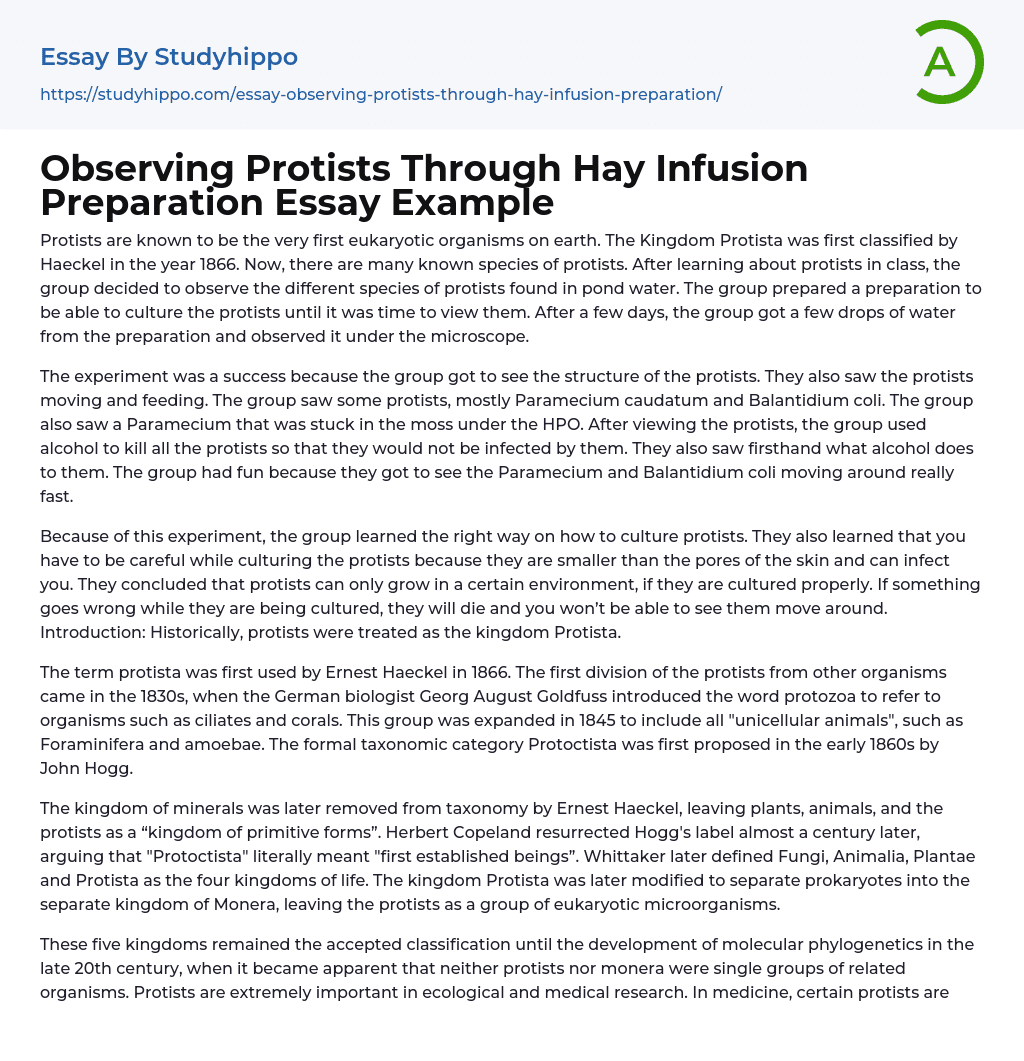

Observing Protists Through Hay Infusion Preparation Essay Example
Protists are known to be the very first eukaryotic organisms on earth. The Kingdom Protista was first classified by Haeckel in the year 1866. Now, there are many known species of protists. After learning about protists in class, the group decided to observe the different species of protists found in pond water. The group prepared a preparation to be able to culture the protists until it was time to view them. After a few days, the group got a few drops of water from the preparation and observed it under the microscope.
The experiment was a success because the group got to see the structure of the protists. They also saw the protists moving and feeding. The group saw some protists, mostly Paramecium caudatum and Balantidium coli. The group also s
...aw a Paramecium that was stuck in the moss under the HPO. After viewing the protists, the group used alcohol to kill all the protists so that they would not be infected by them. They also saw firsthand what alcohol does to them. The group had fun because they got to see the Paramecium and Balantidium coli moving around really fast.
Because of this experiment, the group learned the right way on how to culture protists. They also learned that you have to be careful while culturing the protists because they are smaller than the pores of the skin and can infect you. They concluded that protists can only grow in a certain environment, if they are cultured properly. If something goes wrong while they are being cultured, they will die and you won’t be able to see them move around.
Introduction: Historically, protists were treated as the kingdom Protista.
The term protista was first used by Ernest Haeckel in 1866. The first division of the protists from other organisms came in the 1830s, when the German biologist Georg August Goldfuss introduced the word protozoa to refer to organisms such as ciliates and corals. This group was expanded in 1845 to include all "unicellular animals", such as Foraminifera and amoebae. The formal taxonomic category Protoctista was first proposed in the early 1860s by John Hogg.
The kingdom of minerals was later removed from taxonomy by Ernest Haeckel, leaving plants, animals, and the protists as a “kingdom of primitive forms”. Herbert Copeland resurrected Hogg's label almost a century later, arguing that "Protoctista" literally meant "first established beings”. Whittaker later defined Fungi, Animalia, Plantae and Protista as the four kingdoms of life. The kingdom Protista was later modified to separate prokaryotes into the separate kingdom of Monera, leaving the protists as a group of eukaryotic microorganisms.
These five kingdoms remained the accepted classification until the development of molecular phylogenetics in the late 20th century, when it became apparent that neither protists nor monera were single groups of related organisms. Protists are extremely important in ecological and medical research. In medicine, certain protists are used to study the relationship between chromosomal structure and aging. Multicellular protists as slime molds provide valuable insight about the chemical signals used in more complex organisms to coordinate cellular activity.
- Oxygen essays
- Atmosphere essays
- Coral Reef essays
- Desert essays
- Earth essays
- Ocean essays
- Lake essays
- Sea essays
- Biodiversity essays
- Natural Environment essays
- Forest essays
- Soil essays
- Water essays
- Rainbow essays
- Ecosystem essays
- Volcano essays
- Wind essays
- Forestry essays
- Bottled Water essays
- John Locke essays
- 9/11 essays
- A Good Teacher essays
- A Healthy Diet essays
- A Modest Proposal essays
- A&P essays
- Academic Achievement essays
- Achievement essays
- Achieving goals essays
- Admission essays
- Advantages And Disadvantages Of Internet essays
- Alcoholic drinks essays
- Ammonia essays
- Analytical essays
- Ancient Olympic Games essays
- APA essays
- Arabian Peninsula essays
- Argument essays
- Argumentative essays
- Art essays
- Atlantic Ocean essays
- Auto-ethnography essays
- Autobiography essays
- Ballad essays
- Batman essays
- Binge Eating essays
- Black Power Movement essays
- Blogger essays
- Body Mass Index essays
- Book I Want a Wife essays
- Boycott essays



